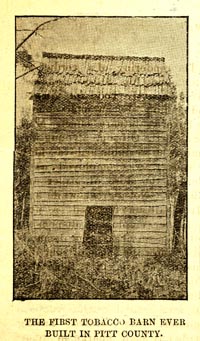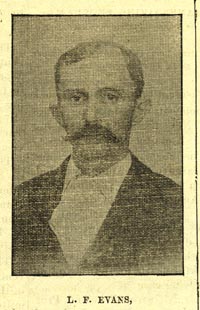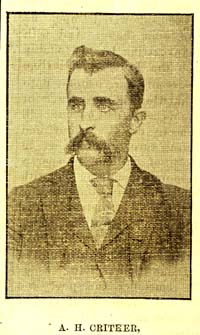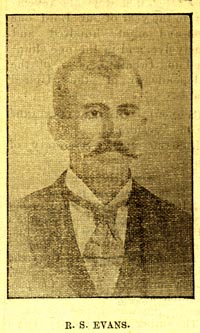That the Eastern Reflector asked tobacconist O.L. Joyner to oversee "The Tobacco Department," a regular column, reflects the importance of tobacco to the local economy. On November 13, 1895, the column began "A series of articles on the history of tobacco culture in the eastern counties." The articles that appeared in November and December, 1895, focus on Greenville and Pitt County. Several of them provide detailed information about and photographs of the men who engaged in various tobacco-related activities, incuding "Our Buyers."
The Reflector Greenville, N. C. D.J. Witchard, Editor and Proprietor Entered at the postoffice [post office] at Greenville, N. C., as second-class mail matter. Wednesday, Nov. 13th, 1895The Tobacco DepartmentConducted by O.L. Joyner, Proprietor Eastern Tobacco WarehouseGreenvilleA Series of Articles on the History of Tobacco Culture in the Eastern CountiesTHE GROWTH AND DEVELOPMENT OF THE GREENVILLE N. C. TOBACCO MARKET.Some Interesting Facts About Greenville Now and Greenville Five Years Ago. About three hundred years ago that gallant Knight, Sir Walter Raleigh, discovered the natives of the Islands of the eastern coast of North Carolina cultivating a plant which they called uppowac or tobacco. We have no facts to show how or when the white people first began to grow tobacco but we do know that the legal statutes of the early days of North Carolina and Virginia are replete with matter pertaining to the regulation and disposition of tobacco at that very early day in the history of the colonies. We know further from Burke's history of Virginia that it was in the eastern counties of Virginia and with that the culture of tobacco was first engaged in by the whites and [the] very strongest laws had to be enacted by his majesty, the King of England, to prevent the planting of too much tobacco to the neglect of other crops such as Indian corn, etc. Why or how it was that the eastern counties came to dispense with tobacco culture the writer doesn't know, unless it was found that it could be grown to better perfection further from the coast, at any rate tobacco has not been planted in the eastern counties of North Carolina as a monetary crop for the last fifty years until a few years ago. Most of our readers know how tobacco culture was introduced into Pitt county, but for the purpose of this article it will bear repetition. In 1886 it was that Mr. L. F. Evans was traveling through Nash county. He noticed that a few of the farmers up there were planting tobacco and he made some investigations and found that it was a paying crop. He noticed, too, that the land was very much of the same nature as was the river upland of the section in which he lived. A number of the farmers up there had clubbed and employed one J. T. Seat from Granville county, to superintend their tobacco crop. As Mr. Seat was not needed in that section another year Mr. Evans talked him in [into] the notion of coming down and looking at our lands and seeing our people. To cut a long story short the result of his visit was that he was employed by the following farmers to superintend a tobacco crop during the year 1886: L. F. Evans, G. F. Evans, A. A. Forbes, T. J. Stancil, and Jacob Joyner. Mr. Seat came down early and selected plant land and had the beds sown.

The next thing in order was the building of barns, and the cut on [the] first page represents the first tobacco barn that was built east of the Wilmington & Weldon Railroad. There were other barns the same year but this was the first one. It was built by Mr. Jacob Joyner, in February 1886, and at present belongs to the writer. The photograph of this barn was taken during the last cutting season while there was tobacco in it in process of curing. As will soon be seen om [on] the cut it is a frame structure lathed and plastered and sixteen feet square each way. The writer well remembers the day it was finished. While plastering was yet soft, Mr. Seat walked to the opposite wall from the door and with his forefinger printed the initials of his name J. T. S. 1886, which can be seen there today. This barn is fairly well preserved and Mr. J. F. Evans who is a judge of curing tobacco says it is the best curing barn on the plantation now. We hope it will last many years yet.

The pioneers in tobacco culture all did not find it a very profitable crop the first year and while some of them were almost discouraged and out of the notion of planting any more, the writer has investigated and found that everyone of the original planters has planted some tobacco every year since the first. Marketing the crop was another obstacle in the way of successfully handling their tobacco. It had to be shipped to Oxford and Henderson to be sold (and by the way a good many ship to these same markets now) The second year a few other neighboring farmers were enticed to plant a small crop and they met with fairly good success. The third year a good many farmers planted small crops in different sections and most all of them made good money out of it. The fourth year, 1890, there was probably a thousand acres planted in this county and nearly everybody made more money out of their tobacco than any other crop. It was during the summer and fall of this year that the writer was at Lexington, Ky. taking a business course. In September we were offered a good position to go West, but seeing so much about Pitt county tobacco in the REFLECTOR we decided to come home and engage in the tobacco business. The whole county was wild almost on the subject of tobacco culture. Wilson was erecting a tobacco warehouse under the management of Capt. E. M. Pace. Rocky Mount had a tobacco warehouse but it had about gone down. With the opening of the Wilson warehouse an outlet was made for our farmers to get rid of their tobacco close to home, so in 1891 three thousand acres of tobacco was planted in Pitt county, a number of farmers in Green [Greene] and Lenoir went into it, and it was estimated that in 1891 five thousand acres were planted in Pitt, Green, and adjoining counties.

1890 had been a good crop year and nearly every farmer that had planted any tobacco in that year increased his crop in '91, besides numbers who had never planted any began cultivating it. The '91 crop was not a good one. The heavy rains in July caused it to fire on the hill, but at this time the culture of tobacco had spread from the little community just above Greenville almost all over Eastern Carolina. Farmers had gone to the expense of making preparations and one poor crop did not discourage them, while some reduced their acreage a great many who had never planted any before planted a few acres. It was in this year, 1891, in June that a meeting of the citizens who were interested in tobacco was called. At this meeting The Greenville Tobacco Warehouse Co., was formed and steps were immediately taken to have a tobacco warehouse built. In the meantime Tarboro was pushing ahead with two tobacco warehouses, Rocky Mount had already had new life infused into its sordid veins and that market too was making a great clamor for prestige. Wilson too was making rapid strides in progressiveward. Several new house [houses] were built there this year and tobacco men were coming in from every quarter to locate in either Wilson, Rocky Mount, or Tarboro and just here we want to call the attention of the reader to the condition of the Greenvill [Greenville] market. In June 1891 the present site of the Greenville Tobacco market is shown in the cut of the old field, nothing but a neglected old pine and broom sedge field, that for years, had almost been considered worthless. On Sept. the 23rd, 1891 the Greenville warehouse was opened for the sale of tobacco. Just a week prior to opening day the writer was sent by Mr. G. F. Evans, who had charge of the house, to visit some of the older markets and try to get buyers [.] Nearly everyone that we approached said that he had an idea of placing a man on the eastern markets but they knew nothing of Greenville. Rocky Mount, Tarboro and Wilson seemed to be the only markets that were known and very much woried [worried] but not discouraged we came back and depended on luck to get someone to buy the tobacco. Nearly everybody knows what a time we had the first year. Some of our merchants came on and bought for a while. A few young men form Oxford and Henderson came down to buy and it was soon reported throughout the county that we were all buying tobacco and shipping it to these markets making money on it.The Greenville Warehouse.This well known and popular Warehouse was the first to be built in Greenville for the sale of leaf tobacco, and the day that marked its advent was the beginning of a new era in the prosperity of the town and community. In June, 1891, a meeting was held here, a stock company organized and this house was the result, its completion being in time to begin the fall business of that year.

The first season the house was conducted by G. F. Evans, who took it through the experimental stage and showed that a market could be established here. The next year he formed a copartnership [co-partnership] with Ola Forbes and they run [ran] the house through two seasons following. The fourth year he formed a copartnership [co-partnership] with R. H. Hayes and L. F. Evans. This season, the fifth since the house was built, it is conducted by Evans & Co. the proprietors being L. F. Evans, A. H. Critcher and R. S. Evans. The manager of the house is L. F. Evans, who though a young man man is [young man is] one of the pioneers in the tobacco industry in Pitt county, and is a thorough, substantial business man. He has been identified with the industry ever since the market was established, being connected with the Greenville warehouse before he became one of its proprietors. He is a man in whom the people have confidence, for when Leon tells them he will do a thing it is done just as he says.

In conducting the house this season he is ably assisted by A. H. Critcher, his brother-in-law, and R. S. Evans, his younger brother. A. H. Critcher, is a native of Person county and has been around tobacco all his life. He knows ever detail about it from the plant bed to the factory and is as good a judge of weed as there is on the market.

R. S. Evans is one of our own boys. Everybody knows Dick and though he is the youngest in the flock he is a hustler from the word go. Taken altogether these young men compose a strong business team and they richly merit the splendid success with which they are meeting.

| Citation: | "Greenville's Progressive Business Men," Eastern Reflector (Greenville, NC), December 12, 1894. |
| Location: | North Carolina Collection, Joyner Library, East Carolina University, Greenville, NC 27858 USA |
| Call Number: | NoCar Microfilm GvER-1 View Catalog Record |